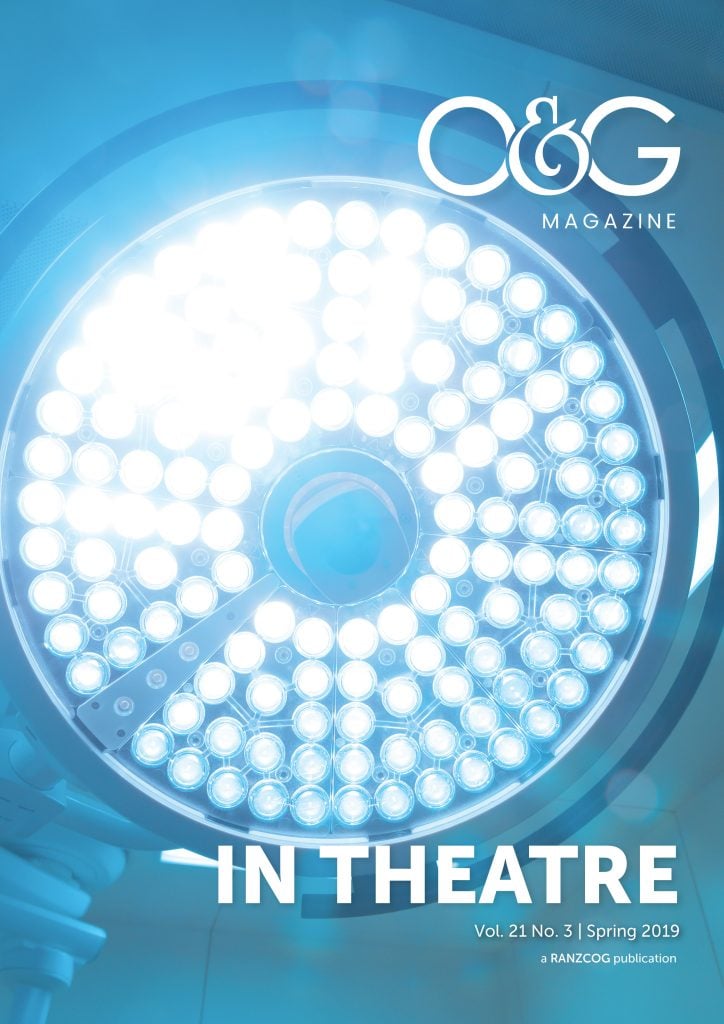Caesarean section surgery comprises approximately 30 per cent of surgeries in low-middle-income countries each year, and is one of the most commonly performed operations worldwide.1 2 3 The Lancet Commissions on Global Surgery 2030 has deemed caesarean section surgery a bellwether operation, a key surgery that needs to be able to be performed in all hospitals.4 5 Access to safe obstetric surgery and anaesthesia for pregnant women is also now part of universal health coverage and Sustainable Development Goal 3.6
In Australia and New Zealand, nearly 115 000 women undergo caesarean section surgery each year.7 Fortunately, unlike many areas of the world, Australia and New Zealand have some of the lowest maternal mortality figures, with mortality being rare and overall pregnancy morbidity being low.8 9 The low maternal morbidity and mortality is due to healthcare systems that support access to high-quality obstetric surgery and anaesthesia.
Despite large numbers of pregnant women undergoing safe obstetric surgery and anaesthesia, and the broad positive impact that this essential surgery has on maternal health in Australia and New Zealand, obstetric surgery (caesarean section surgery) is often left out of the important area of research around, and implementation of, key surgical outcomes and endpoints. It is also rarely covered in the emerging field of perioperative medicine in anaesthesia.10
Perioperative medicine is concerned with the medical management of patients from the time they are considering surgery, through their surgery, to full recovery. It is widely applied in the areas of colorectal, urological, hepatobiliary and gynaecological surgery.11 The marginalisation of obstetric surgery from other important major abdominal surgeries disadvantages pregnant women and their babies, and eventually, if not addressed, will leave these two important populations (pregnant women and babies) behind, once again.
There are likely to be at least two significant reasons why this marginalisation exists. The first is a shift over time in the naming of obstetric surgery from caesarean section, or caesarean delivery, to the emerging term of caesarean birth.12 While the term ‘birth’ is not inaccurate, and may appeal to, and even reassure, some sectors and consumers, it does not ultimately serve to advance the care of pregnant women. Instead, it leads to an underestimation of the risks associated with this surgery by consumers and even their advocates, and to an undervaluing of the contribution made by surgeons (obstetricians) and obstetric anaesthetists to the excellent maternal and neonatal health outcomes for women who undergo this surgery.
The second reason is the assumption that pregnant women’s biological issues are fundamentally different from other adults. This assumption leads to the requirement to segregate an essential surgical operation for a vast number of women from other essential surgeries such as colorectal, cardiac or neurosurgery. Again, while this may provide comfort on the surface, the underlying theme of segregation, this removal from mainstream surgery and anaesthesia, has impacts that ripple through the clinical, research and educational spheres. The creation of metaphorical, and sometimes actual, brick walls between specialties further exaggerates the silo and specialty (and subspecialty) hierarchical mentality so common in medicine. These walls inhibit the development of important personal, departmental, hospital and community collaborations that drive professional respect and understanding, which ultimately lead to better care for pregnant women.
In 2019, as leaders in the safe care of pregnant women in Australia and New Zealand, obstetricians and anaesthetists must reclaim the word ‘surgery’ when it comes to caesarean section and embrace the success we have created – a safe intraoperative environment in which women and their support team can experience the birth of a baby. As a collaborative team, we need to change the view that caesarean section is somehow a lesser mode of birth or a lesser form of surgery. We must ensure that the clinical advances that are occurring in perioperative medicine, anaesthesia and surgery, pain medicine, research, and quantity and safety, are routinely embedded into the perioperative care of pregnant women.13
As leaders, we must also accept the inevitable and luxurious position that a society with low maternal mortality and morbidity can have – that nothing can ever go wrong. Our role is to respect and educate those who should know better, those who have forgotten, and those who have never known what the world looks like without essential obstetric surgery and anaesthesia.
References
- G Molina, TG Weiser, SR Lipsitz, et al. Relationship Between Cesarean Delivery Rate and Maternal and Neonatal Mortality. Journal of the American Medical Association. 2015;314:2263-70.
- SJ Robson, CM de Costa. Thirty years of the World Health Organization’s target caesarean section rate: time to move on. Medical Journal of Australia. 2017;206:181-5.
- T Weiser, AB Haynes, G Molina, et al. Size and distribution of the global volume of surgery in 2012. Bulletin of the World Health Organization. 2016;94:201-9.
- JG Meara, SL Greenberg. The Lancet Commission on Global Surgery Global surgery 2030: Evidence and solutions for achieving health, welfare and economic development. Surgery. 2015;157:834-5.
- AT Dennis. Science, Sex and Society – why maternal mortality is still a global health issue. Anaesthesia. 2016;71:1003-7.
- United Nations. Sustainable Development Goals 2015. Transforming our world; The 2030 agenda for sustainable development A/RES/70/1. World Health Organization. 2015. Geneva, Switzerland. Available from: https://sustainabledevelopment.un.org/content/documents/21252030%20Agenda%20for%20Sustainable%20Development%20web.pdf.
- Australian Institute of Health and Welfare. Australia’s health 2018. Australia’s health series no. 16. AUS 221. 2018. Canberra: AIHW. Available from: www.aihw.gov.au/reports/australias-health/australias-health-2018/contents/table-of-contents.
- Australian Government. Australian Institute of Health and Welfare (AIHW). Maternal deaths in Australia 2016. 2018. Available from: www.aihw.gov.au/reports/mothers-babies/maternal-deaths-in-australia-2016/contents/report.
- Health Quality and Safety Commission New Zealand. Perinatal and Maternal Mortality review Committee. Twelfth Annual Report of the Perinatal and Maternal Mortality Review Committee. 2018. Available from: www.hqsc.govt.nz/our-programmes/mrc/pmmrc/publications-and-resources/publication/3391/.
- AT Dennis, N Sheridan. Sex, suffering and silence – why peri-operative medicine must prioritise pregnant women. Anaesthesia. 2019. doi: 10.1111/anae.14702.
- GA Macones, AB Caughey, SL Wood, et al. Guidelines for postoperative care in cesarean delivery: Enhanced Recovery After Surgery (ERAS) Society recommendations (part 3). Am J Obstet Gynecol. 2019. doi: 10.1016/j.ajog.2019.04.012.
- L Ni, A Elsaharty, I McConachie. Cesarean birth – What’s in a name? Int J Obstet Anesth. 2018;34:5-9.
- AT Dennis, N Sheridan. Sex, suffering and silence – why peri-operative medicine must prioritise pregnant women. Anaesthesia. 2019. doi: 10.1111/anae.14702.






Leave a Reply